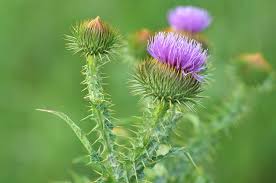
Travelling along our roads and highways, I have taken a serious interest in the many lovely wild plants we routinely see. Some are overwhelming in beauty, and none were planted. They are as wild as the wind. And the wind is responsible for planting many of them, most notably the thistles.
Thistles include a wide range of plants known for their sharp spines and prickles. These beauties will hurt you, but have they ever been magnificent this summer! The thistle I commonly see begins with a strawberry rose flower before morphing into a thistle down, similar to the down of a milkweed. Within the down, though, are many tiny seeds, relished by small birds like the gold finches.
The beautiful thistle flowers are prized by many butterflies and other nectar-loving insects, such as bumblebees. The thistle has been the national emblem for Scotland for nearly a thousand years. The Scots admire the plants beauty and versatility as well as its hardiness. In medieval times, it was said to be a remedy for baldness. Other medical applications of old were said to be cures for headaches, cancer sores, vertigo, jaundice and even “the plague.
Even today, some thistles are used in the manufacture of many pharmaceutical compounds.
To me, a thistle is a thing of remarkable beauty.

